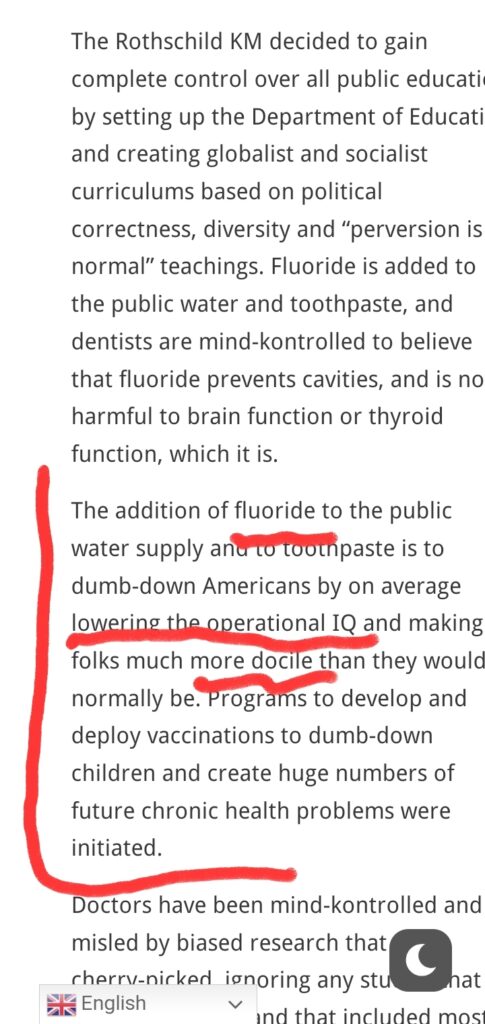Vitiligo is a lack of melanin production and causes areas of the skin to look white or bleached – kind of like becoming an albino slowly in patches. The lack of color patches – freckles in reverse – can start developing when young and can increase with time. The melanocytes, specialized pigment cells, are no longer producing melanin.
The problem doesn’t have a known cause or cure. It is listed as an autoimmune disorder and does seem to run in families. Vitiligo seems to show up after head trauma. [18] “Melanocytes are destroyed by autoimmune activity of unknown origin“, and yet a mother with the condition shared in a patient forum that her white spots move around and became smaller during her pregnancy. [19] That does not sound like permanently damaged melanocytes but more like melanocytes that are getting confused signals from the pituitary or some other controlling gland in the brain (head trauma).It is not “contagious” in the normal sense of the word but Helicobacter pyloris, the bacteria found to be the underlying cause to many cases of stomach ulcers (and successfully treated with antibiotics), was mentioned.[20] Following this thread to the 1945 physician, J. Richard Allison from South Carolina, brought me the sound advice to eat whole grains and don’t depend on new-fangled supplements instead of good diet and still expect to stay healthy [21]. Fixing the underlying problems of low stomach acid during meals and reduced B complex intake helped patients in this physician’s caseload cure their skin conditions. The skin conditions he studied included:
- Metabolic eczema,
- Avitaminosis (pellegra, beri beri, pernicious anemia may be what he means – B vit. deficiencies),
- Urticaria (hives),
- Staphylococcus infection,
- Seborrheic dermatitis,
- Acne rosacea,
- Psoriasis,
- Alopecia,
- Vitiligo,
- Lichen plants (?),
- Lupus erythematosus.
Well hello, bifocals, I hadn’t looked so closely at that list when I first read the article . . . B vitamin complex and whole grains for the whole group of diagnoses and have pickles or vinegar with each meal. Maybe there is a slight metabolic hitch in stomach acid production that normalizing B vitamin intake would restore. Or maybe these patients have a slight fault in their production of stomach acid since birth that will leave them more at risk for developing B vitamin deficiencies throughout life due to the reduced stomach absorption and digestion.
Ninety percent of the vitiligo patients had low hydrochloric stomach acid levels which would leave them digesting things poorly and absorbing B12 poorly (pernicious anemia link). (and maybe growing skin abnormally.)
My grandma had pickles on the table at every meal (because they were left out with the salt, pepper and butter dish). Her dilly beans and bread and butter zucchini pickles were wonderful and would both have good membrane building phospholipids as well as B vitamins. Serving vegetables as pickles turns them into salt and vinegar delivery units. Plain green beans or zucchini would still give the super nutrients of the bean or seed and a larger serving might be eaten. Serving them as a pickle would make the appetite satisfied sooner, triggered by the salt and vinegar signals to the tongue. A small pickle or serving spoon of bread-n-butter slices would probably satisfy the appetite and provide a good amount of the salt and vinegar without being too much.
Equivalent salt and vinegar delivery units in other cultures would be the chutney in Indian cuisine or the salsa in Mexican dishes. The milder creamy cucumber salad of German/European meals is served in larger amounts because the salt and vinegar content is similar to salad dressing rather than the bread-n-butter pickles. The texture is similar though. The advantage of a pickle to my grandma was root cellar storage for winter. Those jars had to last the family until spring. The creamy salad is a fresh cucumber dish which would probably work well with zucchini too.
The current treatment approach for people with vitiligo does not discuss vinegar, pickles, B vitamins or iodine. Steroid cream was mentioned and it is routine to eventually de-pigment the rest of the skin so the whitish patches aren’t standing out from the surrounding darker skin. I don’t know if that process has anything to do with “bleaching” of the skin but the pictures of people with the condition make it obvious to me at least why someone might prefer the more even skin tone that the de-pigmentation would produce. [1, dermnet Vitiligo pictures, some x rated].
I suffered from large patches of eczema off and on since childhood. Ugly, disfiguring and painful; at least the whitish vitiligo patches aren’t reported as painful (physically). I loved pickles as a child and would get scolded for drinking the juice from the (homemade) pickle bottle. I didn’t drink it regularly it is very acidic but I remember craving it occasionally and being scolded if caught by my mother. I don’t crave pickles now because I get too much acidity from my coffee habit. I learned over the years that a smidge of baking soda buffers the coffee. I believe when I used pH strips and checked the coffee was a 4.5 and the baking soda dusting on the end of a spoon handle brought it to 6.5, too much baking soda brought it to a 8 and it was very odd taste of coffee flavor with no tangy zip.
Vitiligo is a condition that I wasn’t familiar with that was listed as having been treated with the herb, gingko biloba. I looked it up and noticed that having vitiligo is also associated with having hypothyroidism. [4]
If you have vitiligo than you may also have hypothyroidism. Why wouldn’t someone be told that he might need iodine or thyroid hormone?
–because few people with the condition pass the lab tests is why and go on to win the synthetic hormone prize.
Hypothyroidism treatment history
Hypothyroidism only exists in the current medical/insurance industry minds if your lab scores match expected values.
I am familiar with hypothyroidism because I had all the symptoms but never got the diagnosis because my TSH was normal. Thyroid Stimulating Hormone levels increase to signal the thyroid gland to grow and gather more iodine in a case of scarcity. Goiters were lumps in the neck from bulging thyroid glands. They were so common in the Middle Ages that they were considered beauty marks if small and well placed. They can be seen in oil paintings from the time.
The current lab tests that the diagnosis is based on don’t recognize that the thyroid hormone might be present but may be malfunctioning. Goiter in the neck is the body’s last resort effort to gather more iodine from the diet. The thyroid gland expands in size in an attempt to gather iodine. Goiter is no longer as prevalent as it was in the 1800’s and earlier. The lab tests that are used currently include the thyroid stimulating hormone level, TSH. A low number is good and an elevated number suggests that the body is trying to stimulate more production of the hormone and would indicate hypothyroidism. Sometimes the actual hormone levels of thyroxine, T3 or T4, are also checked. Those lab tests do not detect whether the hormone is functional, simply whether it is present.
The current medical world doesn’t recognize the fact that if iodine isn’t available then the body makes the hormone with fluoride, bromide or perchlorate, a form of chloride. Iodine is chemically similar to those minerals but they are smaller so if a lab test could be developed that also measured the average molecular weight of the T3 or T4 hormone then we would be able to tell if that sample of thyroid hormone was lighter then it should be. Iodine is the heaviest and fluoride is the lightest of the four elements. Of course we could also simply look at the outward physical signs and symptoms and check the resting body temperature – but that might be inexpensive and slightly less “accurate” (black/white, right/wrong lab tests are nice because they are numerical compared to having to work through a variety of symptom checklists).
Congenital hypthyroidism
Congenital (born with it) hypothyroidism or cretinism is becoming more prevalent and iodine deficiency is not being recognized. A pregnancy can only provide what the woman is eating or has stored. The fetus can not build a body out of it’s mother’s small supply of synthetic thyroid hormone.
Hypothyroidism in a newborn is more common if the newborn is one of the last children of a large family or in pregnancies of multiples (twins, triplets) and when the mother has been diagnosed with hypothyroidism herself. Women are treated with replacement thyroid hormone if they are diagnosed but extra iodine is infrequently recommended. All of the glands of the body need some iodine. The thyroid needs the most and the pituitary gland needs a lot as well as the ovaries and testicles. My fibrocystic breast disease went away when I did the loading dose of Iodine for one month back in 2005. I’ve never had the symptoms return (painful hard breasts – no known cause or cure – just live with it is the typical treatment plan.)
Hypothyroidism in newborns is associated with small size in the children, a short and slim growth pattern leading to cute little pixie children. Infertility and incomplete sexual development is possible with childhood hypothyroidism. Actual genetic problems causing congenital hypothyroidism is rare.
The following quote sums up the treatment approach. Congenital hypothyroidism (CHT) has to do with iodine deficiency – first sentence – but it is usually treated with a daily dose of thyroid hormone . . . for the rest of the child’s life – last sentence.
“The most common cause of this defect is iodine deficiency. CHT is a condition of thyroid hormone deficiency present at birth. Approximately 1 in 4000 newborn infants has a severe deficiency of thyroid function, while even more have mild or partial degrees. If untreated for several months after birth, severe congenital hypothyroidism can lead to growth failure and permanent mental retardation. Treatment consists of a daily dose of thyroid hormone by mouth.” [
3]
If lack of iodine was the problem, then why isn’t it ever thought of as the solution? Iodine in addition to some external thyroid hormone would help the baby to have the immediate metabolic support to grow a normal size with normal glandular development throughout the body.
Prostate and breast cancer and hypothyroidism is less common in the Japanese population (I should look up rates of vitiligo—pdf). The average three year intake of sea vegetables in Japan (rich source of iodine) was 4 grams per day per capita (2005-2007 www.faostat.org). The average sea weed intake has been estimated to provide about 13.3 mg of iodine per day. Our national recommended intake for iodine has never changed or been retested since the initial work done in the 30’s and 40’s. The guideline of 150 micrograms (0.15 mg) is 88 times less than the average Japanese intake of iodine from sea vegetables. (Sea weed is also a good supplier of super fibers for strong membranes and glycocalyx).
Iodine therapy was found ineffective and somewhat dangerous because it isn’t a magic bullet medication. It takes many nutrients and some time to promote normal function. Tyrosine is an amino acid that may need to be converted from other amino acids and problems might exist in that pathway. Selenium is crucial to prevent hyperthyroidism – the body can go into overproduction of the hormone when a sudden supply of iodine becomes available. The selenium is essential to the enzyme that breaks down excess thyroid hormone. Life is a constant cycle of building, break down, and rebuilding.
Vitiligo and melanin production.
Vitiligo is a lack of normal melanin production in the skin. A dietitian type question on a mutli-disciplinary team of research scientists might be – well what is melanin made out of – what do we need to eat more of if we aren’t producing enough?
And how is melanin made?
I discovered that melanin is a pigment that is made out of the amino acid tyrosine with an intermediate chemical step, dihydroxyphenylalanine, also known as dopa, by the enzyme, tyrosinase. Copper is essential and known chemical binders of copper inhibit melanin production [2]. Iron and zinc are also mentioned more in discussion of variations of the chemical. Many different shades are produces throughout the animal kingdom and the melanin chemical is not always exactly the same, so some may have more iron or zinc than copper involved possibly [10 – very interesting but gets very not nutrition science related the farther done the page but I think melanin and iodine and the electromagnetic EPR signal may be involved in protecting us from cosmic ray activity as well as the daily electromagnetic forces that are in our gadgets and telephone pole wires.]
Cysteine is listed as a possible inhibitor of melanin formation as a compound that binds copper – an individual who is no longer able to convert cysteine into taurine very well might end up with increased levels of cysteine. Fluorotyrosine is on the list as a competitive inhibitor. [2] So the iodine connection might be that we have too much fluoride in our water and diet and it fills spots that iodine would have filled if available. Fluoride is used in patent medications because it increase binding affinities – lengthens the time the medication stays in the receptor. Good if you want a non-ending reaction but usually we want what went up to come back down again – that is what homeostasis and life is about.
The iodine connection may also be the tyrosine itself which is part of the thyroid hormone. Radioactive fluoridated dopa (dihydroxyphenylalanine, the intermediate step between the amino acid tyrosine and the pigment melanin) has been successfully used to locate tumors in the thyroid gland [9]. The fact that a radioactive fluoridated version of chemical metabolite of melanin can successfully be used to locate cancerous tumors in the thyroid gland suggests to me that it is involved with thyroid health and iodine as well as melanin and pigmentation or lack of pigmentation in the skin.
Melanin is stored within the membranous folds of the Endoplasmic reticulum and/or Golgi apparatus within the melanocytes. The melanin producing cells seem to have complex paper thin folded layers of membrane and the melanin is part of the membrane folds. [11] The melanocytes in individuals with albinoism do not produce melanin.
Melanin and other color pigments are reactive to light. The black of the melanin pigment absorbs radiation and helps protect us. Pigments also give off a weak magnetic signature of their own.[10, 12] So maybe we do occasionally react to each others’ “animal magnetism”.
Take home point – in order for our bodies to be able to assemble melanin we need the building blocks which include the amino acid tyrosine (and for it to not be fluoridated), copper and adequate supplies of cyclic AMP (energy source and rich in phosphorus).
Low iodine levels may simply be effecting the cyclic AMP energy supply. Fatigue and poor growth of cells that have a rapid growth/death turnover rate is characteristic of hypothyroidism. The outer third of the eyebrow tends to be absent. Brittle fingernails and thinning hair or hair loss is common also. Feeling cold and slow digestion with constipation problems is common, easy weight gain and depression also.
Skin pigmentation in a dark complexion may be simply such a large reservoir of resources that the chronically undernourished body can’t keep up with supplying the tyrosine/dopa. The membranous folds contain a lot of the individual molecules of melanin embedded within the membranes so I also suspect involvement of the phosphorus rich endogenous cannabinoids. Chances are that my membrane building diet will help return pigmentation to skin as long as the problem is one of nutrient supply rather than a defect in a chemical pathway or in the melanocyte.
I added the chemical structures of tyrosine, L-Dopa, and thyroxine at the bottom [15, 16, 17]. Fluoridated thyroxine increases risk of cancer to the thyroid and may be increasing risk of damage to the melanocytes. If the vilitigo blotches have actual structural changes in the melanocytes (like scar tissue is whiter than the surrounding skin) then restoring melanin production may not be possible but improving iodine intake and the other chemicals involved could slow down the progression of the disease. Beans and fruit and tuber/root vegetables are good sources of tyrosine and Dopa [10]. Copper is essential to melanin production but caution with any supplementation is a good idea because zinc balance can be effected by large amounts of copper and we frequently are low in zinc too (Especially good for men, zinc is needed for testosterone – pumpkin seeds are a good source of zinc. Cashews are a good source of copper.)
/Disclosure: This information is provided for educational purposes within the guidelines of fair use. While I am a Registered Dietitian this information is not intended to provide individual health guidance. Please see a health professional for individual health care purposes./
_____________________________________________________________________
- Pictures of individual’s with vitiligo, includes some x rated areas of the body. The condition can occur in people of any skin color, it is just more obvious on the darker skin. [dermnet.com/Vitiligo]
- Biochemistry of Melanin Formation [physrev.physiology.org/content/30/1/91.full.pdf] (page 17, Table 1: Inhibitors of Melanin Formation In Vitro)
- Common and Rare Birth Defects or Congenital Disorders and Their Causes, [healthmad.com/conditions-and-diseases/common-and-rare-birth-defects-or-congenital-disorders-and-their-causes/2/]
- [medicinalplants.us/hypothyroidism ]
- [chemicalelements.com/] “Iodine, Atomic Number 53 (# of protons), Atomic Mass, 126.90447 amu (total weight) Bromide, Atomic Number 35, Atomic Mass, 79.904 amu; Chloride, Atomic Number 17, Atomic Mass, 35.4527 amu; Fluoride, Atomic Number 9, Atomic Mass, 18.998404 amu”
- [medicinalplants.us/ginkgo-biloba-uses-dosage-adverse-reactions] *lists some dosage levels of ginkgo used in peer reviewed studies for a few different conditions. Vitiligo: 120 mg standardised extract daily.
- [ncbi.nlm.nih.gov/pubmed/1287627?dopt=Abstract] Pigment Cell Res. 1992 Nov;5(5 Pt 1):240-6., Melanin standard method: empirical formula, Chedekel MR, Ahene AB, Zeise L.
- [physrev.physiology.org/content/30/1/91.full.pdf] Lerner, A. B. and Fitzpatrick, T. B., Biochemistry of Melanin Formation (Jan, 1950)
- [jnm.snmjournals.org/content/49/4/524.long F-Dihydroxyphenylalanine PET in Patients with Biochemical Evidence of Medullary Thyroid Cancer: Relation to Tumor Differentiation, (Koopmans, Klaas P., et al) doi: 10.2967/jnumed.107.047720 J Nucl Med April 2008 vol. 49 no. 4 524-531
- [tightrope.it/nicolaus/melanin95.htm] “Link 4-Melanin 95-97,In memory of Giovanna Misuraca, Melanins in Plants: “From legumes and from fruit it is possible to isolate tyrosine, DOPA, tyramine, DOPAamine, epinine (N-methyldopamine). The blackening which is seen in the course of maturation and conservation of bananas seems to be due to the neurologic melanogene DOPAamine. The typical blackening of slices of tubers (potatoes) and fruit (apples, pears, etc.) and plants (in the Vicia faba one finds large quantities of DOPA) seems to be a process of melanogenesis from tyrosinase or DOPA.” Melanins in Animals: “The melanins of vertebrates and invertebrates can be observed in the skin, in fur, in hair, in feathers, in scales, in the choroid, in the peritoneum, in the pia mater, in the brain, and in melanomas (malign tumours of an intense black colour). One cannot yet confirm that the various melanins coming from different sources are the same, even though they have the presence of a free radical and the potential capacity to conduct electrical current in common. Sometimes animal melanin has the function of protecting the skin from radiation (short wavelengths), of controlling temperature, of mimetisation. Little or nothing is known of the structure and the functions of neuromelanins (eg. substantia nigra) expecially with respect to the elecrical properties of this pigment (Link 22). Obviously the melanin associated with tumours has been studied more, by biologists.”Melanin as stable free radical. “Studies have been carried out on all the melanins in acqueous suspensions and almost always give an EPR signal at about 4-6 G. The spin concentration is around the value 4-10 x 1017spin/g. In the “polymer” there would be one free radical every 200-1,000 “monomers”. It would seem that there are two radicalic centres in the black products that originate from the o.phenols: one being essential (intrinsic), highly stable, generated in the course of melanogenesis and “trapped” in the product and the another being extrinsic, transient and reactive which can form in the melanin by the action of the different chemico-physical agents. Passing from black melanins to brown and red-brown products (pheomelanins) it is possible to observe radicals with better defined structures, at different pH, like those of semiquinonamine and semiquinone. EPR studies carried out on the hair and skin of several bovine races and on albinoes have mainly been used by geneticists and pathologists. Albino subjects, with the same phenotype character, have hair with differing electronic characteristics. In some albino subjects there is a weak EPR signal which is completely absent in others. There are, that is, true albinoes and false albinoes (6, l). ”
- [ncbi.nlm.nih.gov/pmc/articles/PMC2591998/?page=4] Ultrastructure and cell biology of pigment cells. Intracellular dynamics and the fine structure of melanocytes with special reference to the effects of MSH and cyclic AMP on microtubules and 10-nm filaments. G. Moellmann, J. McGuire, and A. B. Lerner.
- [spectroscopy.lbl.gov/EPR-Robblee/EPR-Robblee.pdf] Electron Paramagnetic Resonance (EPR), John Robblee, Berkeley Spectroscopy Club, (18 April 2001)
- [books.google.com/books] Walter Sneader, Drug Discovery: a history. *I didn’t discover the iodine content of testicular tissue but sheep thyroid had 2.9% iodine content when Eugen Baumann started trying to isolate the active principle of the thyroid gland. In 1896 he got a 10% iodine concentration. Goitre was treated with iodine after this discovery but results were mixed especially with more advanced cases. Adequate selenium is essential to not become hyperthyroid when trying to replenish your body’s iodine level. Selenium is in the enzyme that breaks down the active thyroid hormones. Another researcher, Edward Kendall, isolated a 23% iodine containing chemical in 1910 and had the formula for the thyroid hormone worked out by 1914. “Kendall studiously avoided giving the hormone any name suggestive of the discredited idea that iodine was responsible for thyroid activity.” I don’t see how any molecule that contains 23% by volume iodine couldn’t also be considered to require iodine for proper function. T4 is so called because it has four atoms of iodine (or bromides/fluorides/chlorides) and T3 has three of them.
- Chemical formula for melanin: [natscience.com/Uwe/Forum.aspx/chem/3992/Chemical-Formula-for-Melanin ]
- [chemistry.about.com/od/imagesclipartstructures/ig/Amino-Acid-Structures/Tyrosine.htm]
 |
| Chemical structure of Tyrosine, (C-9-H-11-N-O-3) |
|
|
|
|
|
|
|
 |
| Chemical structure of L-Dopa, |
16: L-DOPA (L-3,4-dihydroxyphenylalanine) is a chemical that is made and used as part of the normal biology of some animals and plants. Some animals including humans make it via biosynthesis from the amino acid L-tyrosine. L-DOPA is the precursor to the neurotransmitters dopamine, norepinephrine (noradrenaline), and epinephrine (adrenaline) collectively known as catecholamines
17. [chemistry.about.com/od/factsstructures/ig/Chemical-Structures—T/Thyroxine.htm]
***This is the thyroid hormone, T4. It has an extra 6 Carbon ring (size of a glucose sugar molecule) but otherwise is similar to tyrosine and L-Dopa. If fluoridated tyrosine could inhibit the production of melanin then it seems plausible that fluoridated thyroid hormone could also. Over the course of time fluoridated chemicals have a cancer promoting effect on the organs. It is well researched in thyroid cancer but the breasts, prostate, pancreas, and other glands contain iodine. Maybe the fluoridated thyroxine is not only not helping cause hypothyroid symptoms while confusing lab tests but is also collecting in melanocytes and occasionally leading to their malfunction. If the melanin is no longer being produced because of cell damage than the function may not be able to be restored but adding iodine to the diet might slow down the progression of the vilitigo blotches (iodine and tyrosine and selenium and adequate copper/zinc balance and phospholipids).
 |
| Chemical structure of Thyroxine, (C-15-H-11-I-4-N-O-4) |





